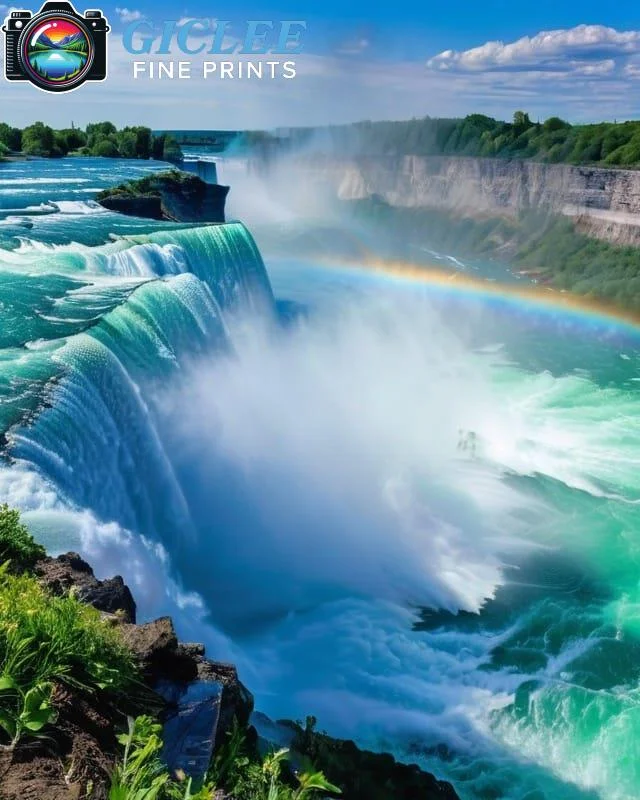
Panel prints offer a versatile and modern way to showcase your fine art, giclee prints, canvas, and even metal prints. Whether you’re decorating a home, office, or gallery, panel prints allow you to experiment with unique layouts and display techniques that can transform any space. At Giclee Fine Prints, we offer high-quality panel prints and framing services that make your artwork stand out.
Grid Layout
The grid layout is a popular method for displaying multiple panel prints in a clean, organized fashion. This style works well when you have a series of prints or images that share a common theme, such as a collection of canvas prints or fine artworks.
Key Tips:
- Symmetry is Key: Arrange the panels in equal rows and columns, ensuring the spacing between each panel is consistent.
- Spacing: Use a measuring tape or a laser level to ensure equal spacing, typically 1-2 inches apart for a neat, cohesive look.
- Unified Theme: This layout works best with prints that have a unified theme, such as landscapes, portraits, or abstract designs.
Best For:
- Minimalist spaces that benefit from clean lines and an organized look, such as modern living rooms, offices, or galleries.
Gallery Wall
A gallery wall allows for more creative freedom, as it involves displaying various sizes and shapes of panel prints in a seemingly random arrangement. This style is perfect for creating an eclectic, art-filled wall that adds character to any space.
Key Tips:
- Mix Sizes and Styles: Combine canvas, fine art paper, and metal prints of different sizes to create visual interest.
- Use a Common Theme: While the sizes and orientations may vary, try to stick to a common theme, such as family photos, nature scenes, or abstract art, to maintain a cohesive feel.
- Trial Layout: Lay the prints out on the floor before hanging to experiment with different configurations until you find one that works.
Best For:
- Home decor where you want to create a personalized and visually dynamic focal point, such as a hallway, living room, or bedroom.
Triptych Display
A triptych is a set of three panel prints that are usually aligned in a row, forming one continuous image or a series of related images. This format works well for large spaces and adds a dramatic touch to the wall.
Key Tips:
- Consistent Spacing: Keep the spacing between the panels consistent—typically 1-2 inches apart—for a seamless look.
- Horizontal or Vertical: While triptychs are commonly displayed horizontally, you can also arrange them vertically to add height to the room.
- Framed or Frameless: Triptych panels can be framed for a polished look or left unframed for a more modern, minimalist appearance.
Best For:
- Living rooms, dining rooms, or offices with large wall spaces that need a statement piece.

Floating Panels
Floating panels are mounted in such a way that they appear to “float” off the wall, creating depth and dimension. This technique is particularly striking with metal prints and canvas prints, as the artwork seems to hover, adding a modern aesthetic to any room.
Key Tips:
- Use Floating Frames: Floating frames leave a gap between the print and the frame, emphasizing the floating effect.
- Wall Spacers: Attach wall spacers to the back of the print to lift it off the wall slightly. This adds a shadow effect and makes the print stand out.
- Minimalist Approach: Floating panels work best with minimalist or abstract designs, enhancing the modern appeal of the artwork.
Best For:
- Modern interiors where clean lines and sleek designs are a priority, such as office spaces, modern homes, or galleries.
Split Image Layout
A split image layout involves dividing one image into multiple panels. This style creates a dramatic effect, as the panels work together to form a complete image when viewed from a distance. The split image can be applied to canvas prints, metal prints, or fine art paper.
Key Tips:
- Panel Alignment: Ensure the panels are hung in alignment to create a seamless flow between them. Use a level to maintain straight lines.
- Image Type: This technique works particularly well with landscapes, cityscapes, or large-scale abstract art that can be broken down into multiple sections.
- Consistency in Size: Keep the panels uniform in size for a balanced look.
Best For:
- Large spaces where you want to create a bold, eye-catching focal point, such as entryways, living rooms, or commercial spaces.
Diagonal or Asymmetrical Display
For a more unconventional and dynamic presentation, try arranging your panel prints diagonally or in an asymmetrical pattern. This display style draws attention and can be a fun way to showcase vibrant or abstract artwork.
Key Tips:
- Create Movement: Arranging the panels diagonally or unevenly gives the impression of movement, which can energize the space.
- Mix Sizes: Vary the sizes of the panels for added visual interest, and experiment with different orientations—horizontal and vertical—within the layout.
- Balance: While the layout may be asymmetrical, aim to balance the overall composition by distributing visual weight evenly across the wall.
Best For:
- Creative spaces, such as art studios, offices, or living rooms, where you want to inject a sense of playfulness and creativity into the decor.

Leaning Panels
Instead of hanging your panel prints, consider leaning them against the wall for a casual, modern look. This method works especially well with larger canvas or metal prints, and it allows for easy rearrangement if you want to change up the display.
Key Tips:
- Layering: Lean multiple prints of different sizes against the wall, layering smaller panels in front of larger ones for depth.
- Anchor with Furniture: Place the prints on a shelf, mantel, or atop a console table to keep them secure and integrated into the room’s decor.
- Rest Against the Wall: For a larger panel, you can simply rest it against the wall at floor level for a relaxed, artistic vibe.
Best For:
- Living rooms, bedrooms, or entryways, where you want a more laid-back, effortless display without the need for wall mounting.
Backlit Panels
For a dramatic and modern look, consider adding backlighting to your panel prints. LED strips or soft lighting behind the panels create a glowing effect that draws attention to the artwork and adds warmth to the room.
Key Tips:
- LED Light Strips: Attach LED light strips behind the panels to create a halo effect. Ensure the lighting is soft and diffused for a subtle glow.
- Frame Depth: Use frames with enough depth to accommodate the lights and allow space for the illumination to spread evenly.
- Focus on Modern Art: This technique works best with modern or abstract prints where the lighting enhances the design without overpowering it.
Best For:
- Modern interiors, especially in dimly lit rooms, such as home theaters, bedrooms, or contemporary living spaces.
Contact Us
Our address is: 3816 Pioneer Trail Ste #3, South Lake Tahoe, CA 96150
Email: Info@gicleefineprints.com
FAQs
A grid layout or gallery wall is ideal for displaying multiple panels, as they offer clean, organized ways to showcase your prints.
Yes, leaning panels against the wall or placing them on furniture is a popular method for creating a casual, contemporary display.
For most displays, spacing panels 1-2 inches apart is ideal. However, the spacing may vary depending on the overall size and layout of the prints.


